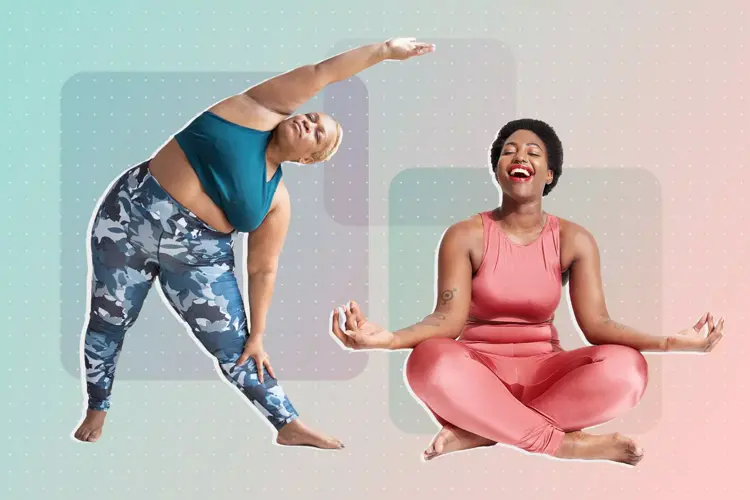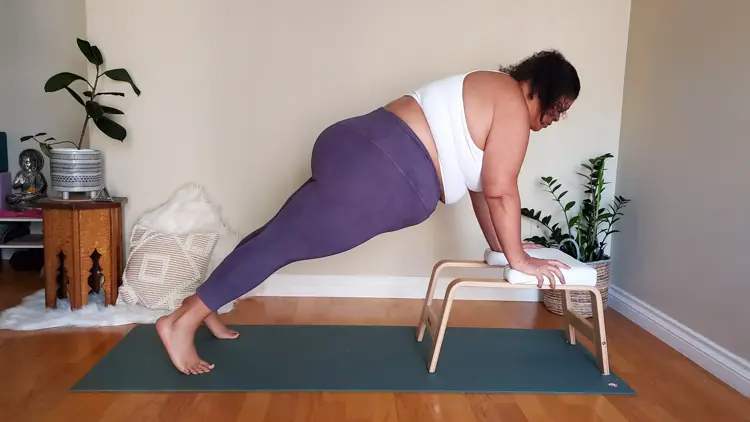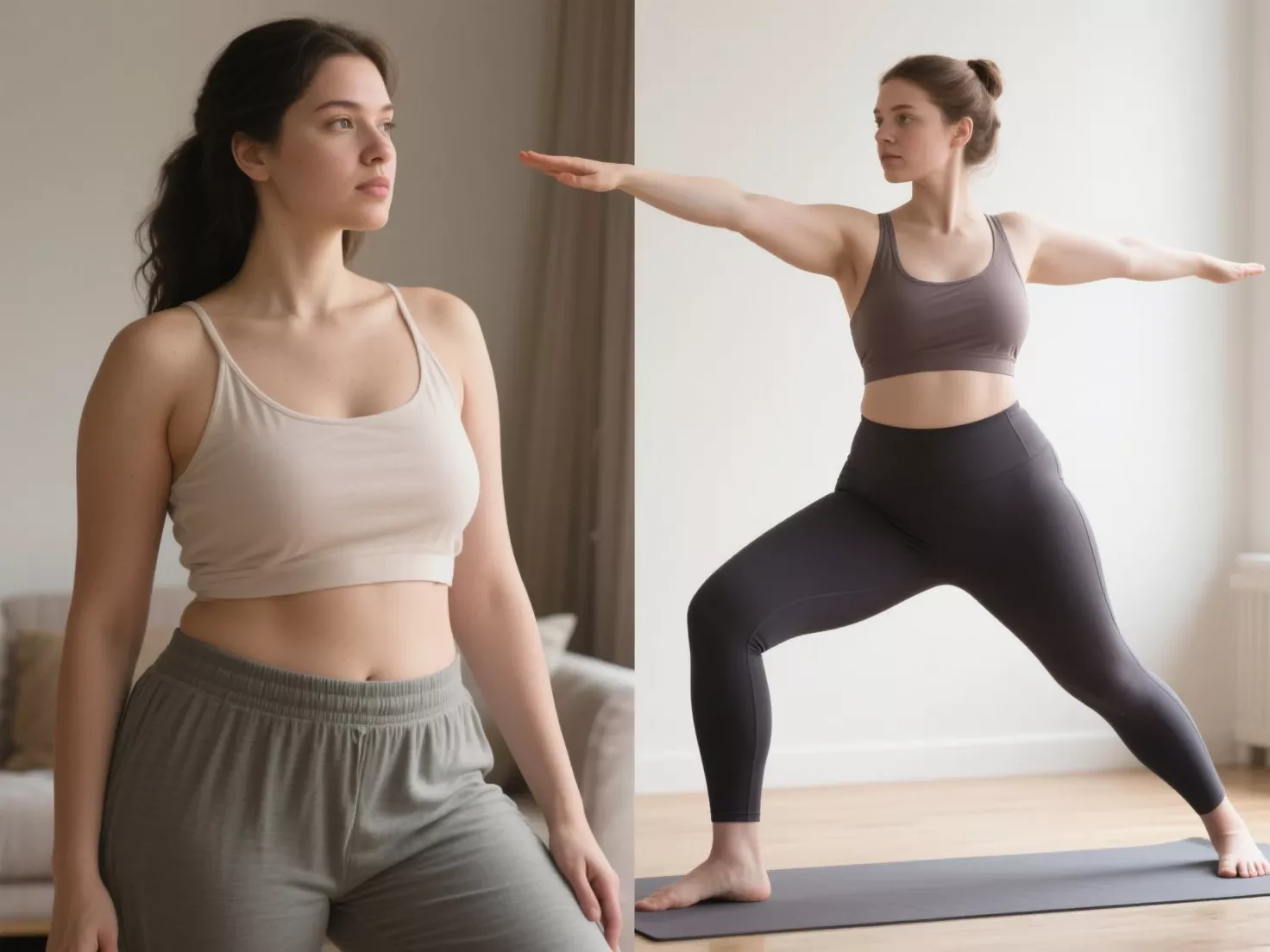Absolutely! Yoga is an inclusive practice that benefits individuals of all body types, including those who are plus size.
Contrary to common misconceptions, yoga is not just for the slim and flexible—it’s a practice designed to meet you where you are, regardless of your size, shape, or fitness level.
Yoga can improve flexibility, strength, and balance while promoting mental well-being and self-acceptance.

Here’s a detailed exploration of why yoga is good for plus size individuals and how to make the most of your practice.
Benefits of Yoga for Plus Size Individuals
1. Improves Physical Health
Yoga is a low-impact form of exercise that strengthens muscles, improves flexibility, and enhances overall fitness. It can also support weight management and cardiovascular health.
Key Benefits:
- Builds core and muscle strength without straining joints.
- Enhances mobility and flexibility over time.
- Improves balance and posture, reducing the risk of falls or injury.
Recommended Poses:
- Cat-Cow Pose (Marjaryasana-Bitilasana) for spinal flexibility.
- Warrior II (Virabhadrasana II) for strength and balance.
- Seated Forward Bend (Paschimottanasana) for hamstring flexibility.
2. Supports Mental Health and Stress Relief
Yoga is renowned for its ability to reduce stress, anxiety, and depression.
Plus size individuals, who may face societal pressures or stigma, can benefit from yoga’s focus on mindfulness and self-compassion.
Key Benefits:
- Promotes relaxation through deep breathing and meditation.
- Encourages body positivity and acceptance.
- Helps develop a mindful connection with your body, improving confidence.
Recommended Practices:
- Yoga Nidra (guided relaxation) for stress relief.
- Alternate Nostril Breathing (Nadi Shodhana) for mental clarity.
3. Inclusive and Adaptable
Yoga is highly adaptable, with modifications available for every pose. This means anyone can practice yoga, regardless of fitness level or body type.
Key Benefits:
- Props like blocks, straps, and bolsters make poses more accessible.
- Teachers can suggest modifications to suit individual needs.
- Many yoga studios and online platforms now offer plus size-specific classes.
4. Encourages a Healthy Relationship with Your Body
Yoga teaches self-acceptance and compassion, helping individuals embrace their bodies and focus on what they can do rather than on limitations.
Key Benefits:
- Encourages body awareness and mindfulness.
- Shifts the focus from appearance to function and inner strength.
- Builds self-esteem and a positive outlook.
Common Myths About Yoga for Plus Size Individuals
Despite yoga’s growing inclusivity, certain misconceptions persist, discouraging plus size individuals from exploring the practice.
These myths often stem from societal stereotypes or a lack of representation in mainstream yoga media.
Let’s debunk these common myths and shed light on the truth about yoga’s accessibility for people of all body types.
Myth 1: Yoga Is Only for Thin and Flexible People
- The Misconception: Many believe that yoga is reserved for those with slim, athletic bodies who can effortlessly twist and bend into challenging poses.
- The Truth:
Yoga is for every body, regardless of size, age, or flexibility level. Flexibility and strength are not prerequisites for yoga—they are benefits you develop over time with consistent practice.
Yoga is a journey that starts where you are, not where you think you need to be. - Why This Myth Persists:
Media portrayals of yoga often feature thin, hyper-flexible individuals, creating a skewed perception of who yoga is for. - How to Overcome It:
- Seek out diverse yoga communities and teachers who represent a range of body types.
- Focus on yoga’s foundational goal: self-awareness and growth, not achieving a specific look or pose.
Myth 2: Certain Poses Aren’t Possible for Plus Size Individuals
- The Misconception:
Larger bodies are often perceived as incapable of performing certain yoga poses due to size or mobility limitations. - The Truth:
Most yoga poses can be adapted to suit all body types using props, modifications, or alternative techniques.
Plus size individuals can perform the same poses as anyone else with the right guidance and adjustments. - Why This Myth Persists:
A lack of education about yoga props and modifications leads to the false assumption that some poses are inherently “off-limits.” - How to Overcome It:
- Learn how to use props like blocks, straps, and bolsters to make poses more accessible.
- Work with instructors trained in adaptive yoga who can suggest modifications tailored to your needs.
- Start with beginner-friendly poses and gradually progress as you build confidence and strength.
Myth 3: You Need to Lose Weight Before Starting Yoga
- The Misconception:
Some believe that yoga requires a certain fitness level or body size, making weight loss a “prerequisite” for practicing yoga. - The Truth:
Yoga is a practice for everyone, no matter their weight or fitness level. In fact, yoga can be a supportive tool for weight management, but its primary benefits extend far beyond physical appearance.
It helps improve flexibility, strength, and mental health while promoting self-acceptance. - Why This Myth Persists:
Social pressures to look a certain way can create feelings of inadequacy or fear of judgment in yoga spaces. - How to Overcome It:
- Remind yourself that yoga is about personal growth and not about meeting external expectations.
- Look for body-positive yoga instructors and studios that foster inclusive environments.
Myth 4: Plus Size Individuals Can’t Do Advanced Yoga
- The Misconception:
Advanced poses like arm balances or inversions are often seen as unattainable for larger bodies. - The Truth:
Plus size individuals can absolutely achieve advanced yoga poses with practice and proper technique.
Strength, balance, and flexibility—not body size—are the key factors in mastering advanced poses, and these qualities can be developed over time. - Why This Myth Persists:
The assumption that larger bodies lack strength or agility perpetuates this misconception. - How to Overcome It:
- Focus on building foundational strength and balance before progressing to advanced poses.
- Practice under the guidance of an experienced instructor who can help you safely achieve challenging poses.
- Celebrate incremental progress and trust your body’s capabilities.
Myth 5: Yoga Classes Are Intimidating for Plus Size Individuals
- The Misconception:
Many believe yoga studios are unwelcoming environments filled with judgmental people or an exclusive “yoga culture.” - The Truth:
While some yoga spaces may lack diversity, many studios and instructors prioritize creating an inclusive and supportive atmosphere.
Yoga is meant to be a personal practice, and most practitioners are focused on their own journey rather than judging others. - Why This Myth Persists:
Media representations of yoga classes often portray them as elitist or inaccessible, deterring plus size individuals from participating. - How to Overcome It:
- Research inclusive yoga studios or online communities that celebrate body diversity.
- Attend beginner-friendly classes where the focus is on learning and exploration.
- Practice self-compassion and remember that you belong in any yoga space.
Myth 6: Yoga Isn’t Effective Exercise for Plus Size Individuals
- The Misconception:
Some think yoga is too gentle or slow-paced to be an effective form of exercise for larger bodies. - The Truth:
Yoga can be as gentle or intense as you make it. Many styles, such as Vinyasa or Power Yoga, offer a full-body workout that builds strength, burns calories, and enhances cardiovascular health.
Even gentler styles improve flexibility, balance, and joint health, making yoga a well-rounded form of exercise for any body type. - Why This Myth Persists:
Misunderstanding of yoga’s versatility as a physical and mental practice leads to this false belief. - How to Overcome It:
- Try dynamic styles like Vinyasa or Ashtanga if you’re looking for a more vigorous workout.
- Set personal fitness goals and track your progress through yoga.
- Pair yoga with other physical activities, such as walking or swimming, for a holistic fitness routine.
The myths surrounding yoga and plus size individuals are rooted in societal stereotypes and misinformation, but they shouldn’t deter anyone from exploring this inclusive and transformative practice.
Yoga is for every body, and with the right approach, it can become a source of strength, confidence, and self-acceptance.
Whether you’re new to yoga or looking to deepen your practice, remember that your journey is unique and valid—just as you are.
Tips for Plus Size Individuals Starting Yoga

1. Find the Right Class
Look for beginner-friendly or plus size-specific classes, either in studios or online, where instructors are experienced in offering modifications.
2. Use Props to Your Advantage
- Blocks can support poses like Triangle Pose (Trikonasana).
- Straps can help with poses like Seated Forward Bend (Paschimottanasana).
- Bolsters provide comfort in restorative poses like Child’s Pose (Balasana).
3. Listen to Your Body
- Practice at your own pace and avoid pushing yourself into discomfort.
- Rest in poses like Child’s Pose whenever needed.
4. Focus on Breath and Mindfulness
- Breathing is the foundation of yoga; deep, mindful breaths help you stay focused and relaxed.
5. Build Confidence Gradually
- Start with simple poses and progress to more challenging ones as you gain strength and flexibility.
Best Yoga Styles for Plus Size Individuals
Yoga is a versatile practice with styles to suit every body type and fitness level. For plus size individuals, the key is finding yoga styles that emphasize accessibility, comfort, and progression at your own pace.
These styles cater to diverse needs, helping you build strength, improve flexibility, and cultivate mindfulness.
Here’s a detailed guide to the best yoga styles for plus size practitioners:
1. Hatha Yoga
Why It’s Great for Plus Size Individuals:
Hatha yoga focuses on basic poses, breath control, and alignment, making it an excellent entry point for beginners.
The slower pace allows you to explore each posture in detail and learn how to adjust them to suit your body.
Key Features:
- Combines foundational poses with breathing exercises.
- Offers a balanced mix of gentle stretches and strength-building poses.
- Encourages mindfulness and body awareness.
What to Expect:
- Basic poses like Mountain Pose (Tadasana), Warrior II (Virabhadrasana II), and Cat-Cow (Marjaryasana-Bitilasana).
- Emphasis on steady breathing and holding poses to develop stability.
Best For:
Beginners who want to build confidence and a strong foundation.
2. Restorative Yoga
Why It’s Great for Plus Size Individuals:
Restorative yoga focuses on relaxation and recovery, using props like bolsters, blankets, and blocks to fully support your body in passive poses.
This style helps release tension, reduce stress, and foster a deep sense of calm.
Key Features:
- Poses are held for extended periods (5–10 minutes) to promote deep relaxation.
- Minimal physical effort, allowing the body to rest and restore.
- Focuses on mindfulness and breathwork.
What to Expect:
- Gentle poses like Reclining Butterfly (Supta Baddha Konasana), Child’s Pose (Balasana), and Legs-Up-The-Wall Pose (Viparita Karani).
- A tranquil environment with soothing music or silence.
Best For: Individuals seeking stress relief, emotional balance, or recovery from physical or mental fatigue.
3. Yin Yoga
Why It’s Great for Plus Size Individuals:
Yin yoga targets the deeper connective tissues and joints through slow, meditative stretches.
It’s perfect for improving flexibility and fostering a sense of stillness and introspection.
Key Features:
- Long-held poses (3–5 minutes) that encourage mindfulness and patience.
- Focuses on flexibility and joint health without physical strain.
- Enhances circulation and releases tension.
What to Expect:
- Poses like Seated Forward Fold (Paschimottanasana), Dragon Pose, and Reclined Twist (Supta Matsyendrasana).
- Use of props to make poses accessible and comfortable.
Best For:
Those looking to improve flexibility, relieve tension, and explore meditative practices.
4. Vinyasa Yoga
Why It’s Great for Plus Size Individuals:
Vinyasa yoga involves flowing sequences that link breath with movement. It provides a moderate to vigorous workout while improving coordination and strength.
With the right modifications, plus size individuals can enjoy the dynamic nature of this practice.
Key Features:
- Combines strength-building and cardiovascular elements.
- Focuses on continuous, fluid movement to create a “flow.”
- Allows for creativity in sequencing, making it adaptable for all levels.
What to Expect:
- Sun Salutations (Surya Namaskar) and other flowing sequences.
- Opportunities to modify poses like Downward Dog (Adho Mukha Svanasana) or Plank Pose for comfort and accessibility.
Best For: Those who enjoy movement and want to build endurance, strength, and flexibility.
5. Chair Yoga
Why It’s Great for Plus Size Individuals:
Chair yoga is an adaptable practice that uses a chair for support, making it accessible for individuals with mobility limitations or those who prefer seated poses.
It allows you to enjoy the benefits of yoga without the need for a traditional mat-based practice.
Key Features:
- Seated poses that improve flexibility and strength.
- Accessible for all fitness levels and abilities.
- Focuses on breathing, mindfulness, and gentle movement.
What to Expect:
- Modified poses like Seated Cat-Cow, Chair Warrior, and Seated Forward Bend.
- Emphasis on posture, alignment, and breath awareness.
Best For: Individuals with joint pain, balance concerns, or limited mobility.
6. Kundalini Yoga
Why It’s Great for Plus Size Individuals:
Kundalini yoga combines breathwork, chanting, and physical poses to promote spiritual and emotional well-being.
It’s a great option for those seeking a more meditative and holistic yoga experience.
Key Features:
- Blends physical, mental, and spiritual practices.
- Focuses on energy flow and emotional balance.
- Accessible poses paired with guided breathing and mantra chanting.
What to Expect:
- Gentle poses like Spinal Flexes, seated meditations, and simple kriyas (movement sequences).
- Breath techniques like Alternate Nostril Breathing (Nadi Shodhana) or Breath of Fire.
Best For: Those looking for a transformative, introspective practice that connects body and spirit.
7. Power Yoga (with Modifications)
Why It’s Great for Plus Size Individuals:
Power yoga is a fitness-focused style that builds strength and stamina. While it’s more intense, with modifications and a gradual approach, plus size practitioners can enjoy its invigorating benefits.
Key Features:
- High-energy sequences designed to tone muscles and boost endurance.
- Builds heat and promotes cardiovascular fitness.
- Emphasizes strength and flexibility.
What to Expect:
- Dynamic poses like High Lunge (Crescent Pose), Plank Pose, and Warrior Sequences.
- Opportunities to modify or rest when needed.
Best For: Those who enjoy challenging workouts and want to build strength and confidence.
Conclusion
Yoga is a powerful tool for enhancing physical, mental, and emotional well-being, and it’s accessible to everyone, including plus size individuals.
By embracing yoga, you can build strength, improve flexibility, and cultivate self-confidence while fostering a positive relationship with your body.
Whether you’re a beginner or looking to deepen your practice, yoga offers endless opportunities for growth and transformation.



